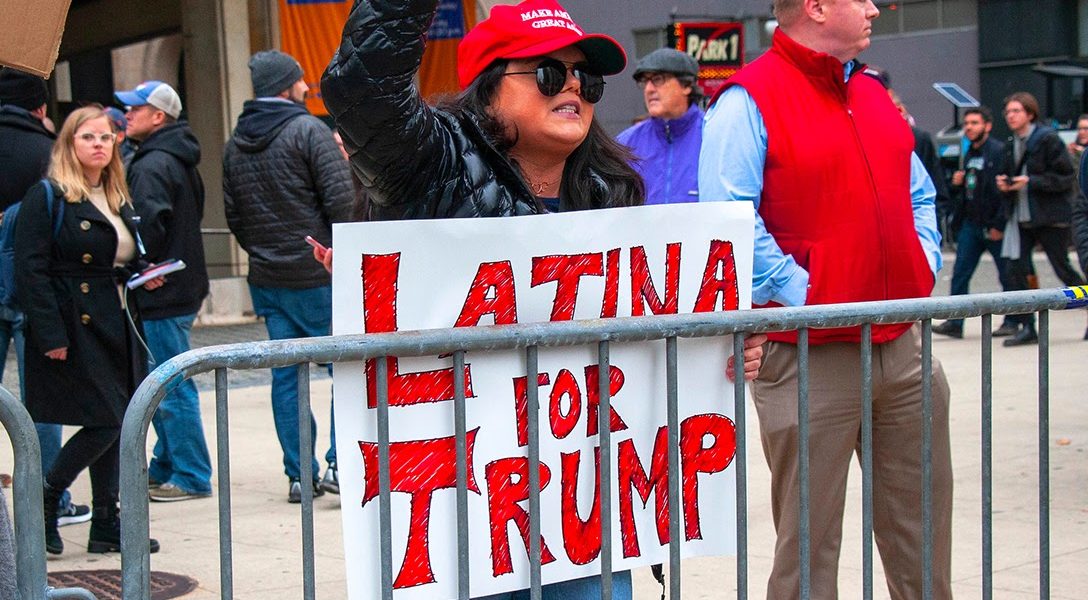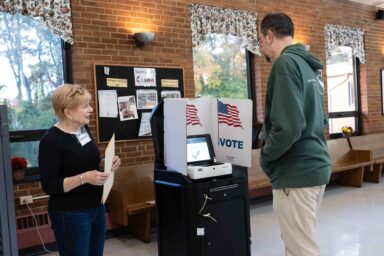A look at how the Republican party, long associated with draconian immigration and racial policies, continues to gain Hispanic voters.
Every four years the Hispanic vote is suddenly rediscovered by politicians and pundits. What gets forgotten is that since 1972, Hispanics have voted for Republicans in ever-greater numbers.
Some politicians assume Hispanic Republicans are a contradiction in terms. Nixon understood they were not, and Reagan had a comprehensive strategy to court them that involved family values, work ethic, patriotism, and identity politics.
The Democrats, on the other hand, have long taken much of this voting bloc for granted.
In the recent election Trump expanded Hispanic support for the GOP. To help us understand a phenomenon that may determine the outcome of future elections, we are joined for this week’s WhoWhatWhy podcast by Geraldo Cadava, professor of history and Latinx studies at Northwestern University.
Cadava explains how Hispanics have grown less alienated from the political process. He shows that they are not a monolith, but a diverse population, ranging in their political views from conservative to liberal to progressive. Like most groups, their votes divide by gender, education, and age; and like other immigrant groups, their country of origin matters, as does military service.
Thanks to years of outreach, Cadava points out, the Republican Party has created a deep sense of loyalty among some Hispanics. He details this bond, which still confounds some political observers, in his book The Hispanic Republican: The Shaping of an American Political Identity, from Nixon to Trump — and in this illuminating podcast.



Click HERE to Download Mp3
Full Text Transcript:
As a service to our readers, we provide transcripts with our podcasts. We try to ensure that these transcripts do not include errors. However, due to time constraints, we are not always able to proofread them as closely as we would like. Should you spot any errors, we’d be grateful if you would notify us.
| Jeff Schechtman: | Welcome to the WhoWhatWhy Podcast. I’m your host, Jeff Schechtman. The great baseball manager Casey Stengel famously said that he never makes predictions especially about the future. That also might be good advice for political pundits. For months in the run-up to the election, we heard pundits talk about the Latino vote, that they were all reachable by Democrats and it was just a matter of Democrats committing more time, more energy, and resources. Latinos were just waiting to be given a reason to vote for Democrats. The problem is the demographics, history, culture, and the hard numbers of the election results themselves tell us that this is simply not true. |
| Jeff Schechtman: | Since around 1972, Hispanic Republicans have developed their own partisan identities and an actual loyalty to The Republican Party. Even to this day, there were issues that continue to draw Latino voters into The Republican Party. Imagine if this took place in the Trump era, what it would mean in the future for Republicans. Clearly, Latinos are not a monolithic group, but rather complicated human beings that are not just pieces to be moved around on a political chess board. Bringing this all into bold relief is our guest today, Geraldo Cadava. Geraldo Cadava is an associate professor of history and Latinx studies at Northwestern University and his new book garnering lots of national attention is The Hispanic Republican: The Shaping of an American Political Identity, from Nixon to Trump. Geraldo, thanks so much for joining us. |
| Geraldo Cadava: | Thank you so much for having me, Jeff. It’s great to be here. |
| Jeff Schechtman: | So interesting how both sides have called Hispanics and Latinos natural Democrats or natural Republicans. There’s a couple of quotes that I know you’ve talked about in the past that Harry Reid, the former majority leader Senator from Nevada said he couldn’t understand how a single Hispanic could be a Republican and going all the way back to Ronald Reagan who said that Latinos are Republicans who just didn’t know it yet. Talk about that first. |
| Geraldo Cadava: | Well, I just think that those statements have to be heard as nothing more than efforts to capture some sort of partisan advantage, because I just don’t think Hispanics or Latinos, and I guess for the purpose of this conversation, I’ll stick with Hispanics since that’s the term I use in my book, because it’s the term preferred by most Hispanic conservatives, but I think that there’s just no such thing as a natural Hispanic anything, whether it’s liberal or Democrat. I just don’t think that’s how partisan identity develops. I don’t think we’re born naturally anything. |
| Geraldo Cadava: | I think our partisan identities evolve over time in our conversation with our families, with our communities, our own sense of what’s just and right in the world. And so it’s a complicated business. And I think the risk of just asserting that Latinos are naturally one way or the other in naturally anything is just that it keeps us in the cycle of not understanding the complexities of Latinos. |
| Jeff Schechtman: | Talk a little bit about how that mythology evolved as you see it. How did this conventional wisdom develop that assumed for so long that Hispanic voters were not going to vote Republican? |
| Geraldo Cadava: | I think it’s developed over a long period of time. I think Hispanic Republicans, even in the 1950s and 1960s when they were starting to build a Hispanic Republican movement would talk about the fierce loyalty to The Democratic Party that Latinos developed beginning in the 1930s during Roosevelt’s New Deal, because Roosevelt put more food on the table, helped Latinos find jobs in moments that were difficult for them. And so a fierce loyalty developed to The Democratic Party and Hispanic Republicans beginning in the 1950s tried to start cracking that loyalty by saying things like, “What have you Latinos actually gotten for your loyalty to the Democrats when the Democrats continue to prioritize and care more about other groups?” And so they started to make the argument that all Latinos are going to be better off if both parties take us seriously and fight for our votes. |
| Geraldo Cadava: | So I think the idea that the fight over the idea that Hispanics are either naturally liberal or naturally conservative started to develop in the fifties and sixties when political parties for a whole variety of reasons we can talk, about started taking Latinos more seriously as a voting block, primarily because they were concentrated in newly electoral-rich states like Texas, California, and Florida. |
| Jeff Schechtman: | Talk about the early stages of that going back to 1972 and the way that came about. |
| Geraldo Cadava: | I mean, I think you could go back even a little further to the Eisenhower years and the Goldwater years, but the efforts in the fifties and sixties really were kind of localized, maybe regional concentrated in the Southwest, New York and Florida hadn’t really become that important because many Cuban-Americans didn’t naturalize in great numbers until the 1970s because for much of the 1960s, they were still focused on politics in Cuba and ousting Castro and forming a government in exile, planning for the moment when they could return triumphantly to Cuba. So they didn’t really invest in American politics until the 1970s and much more in the 1980s. |
| Geraldo Cadava: | So this moment, this movement in the 1950s and sixties really was kind of massive and emerging and it hadn’t fully coalesced. But Richard Nixon, during his first term, again for a whole variety of reasons, made a much more concerted effort among Latinos. Part of it had to do with the fact that he was from California and has a whole story about his upbringing that he grew up near Mexican-Americans and was familiar with their issues. Many Mexican-Americans from Southern California really bought into that idea and thought that he was a politician who represented them. |
| Geraldo Cadava: | He also had strong connections with the Cuban community in Miami, and one of his best friends was Bebe Rebozo and this was also a moment when African-Americans were fleeing from The Republican Party, after The Republican Party’s decision to oppose the Civil Rights Act and to embrace the Southern strategy. And Republican strategist knew that The Republican Party had to replace those lost votes by courting votes elsewhere, and Latinos became a prime target. So there were a lot of reasons that came together during Nixon’s first administration to really cause him to boost his party’s efforts to recruit Latinos. |
| Jeff Schechtman: | And those efforts continued through the Reagan years, but after that, and even towards the later stages of that, it began to change. What happened? |
| Geraldo Cadava: | Yeah, well one, one main shift from the Nixon years to the Reagan years is that Nixon really based his outreach efforts on a politics of patronage and he wanted to create more federal government jobs for Latinos, and he made some high level appointments like the first Hispanic treasurer of the United States. There were some issues like anti-communism, economic uplift, these were issues in the Nixon years, but Reagan was really the first president to try to work with his Hispanic campaign advisors to articulate the kind of core ideas that made Latinos conservative. And they settled on family values and patriotism and a work ethic and anti-communism, things like that. |
| Geraldo Cadava: | And so the playbook for reaching out to Latinos has remained remarkably consistent from the 1980s to the present. And I think the same issues that Trump focused on are the issues that Reagan focused on as well. But in the meantime, The Republican Party changed. I think beginning during the Reagan years, a kind of nativist and xenophobic wing grew within The Republican Party and it’s represented by organizations like the Federation for American Immigration Reform that wanted to limit the growth of immigration. Also the development of US English, this movement to try to pass a constitutional amendment to make English the official language of the United States for a while in the 1980s, a woman named Linda Chavez who also worked in the Reagan administration and still today is kind of leading Latino conservatives, she was the president of US English. |
| Geraldo Cadava: | And I think most importantly, you have the rise of a kind of primary challenger like Pat Buchanan, who really based his primary campaign on nativism and xenophobia and called for the construction of a border wall in 1992. So in 1992, that’s when he won like 37% of primary votes against George W. Bush, George H. W. Bush and therefore kind of had a significant influence in crafting the party platform. So basically what happened in the nineties is the party moved further to the right on immigration and border control and since then Hispanic and Latino Republicans have had to, in a much more concerted way, justify their continued support for The Republican Party. |
| Jeff Schechtman: | And of course, California was in many ways a symbol of what was going on back in the mid nineties with Prop 187. |
| Geraldo Cadava: | Absolutely. I mean, yeah, Prop 187 is still kind of thought of as the death knell for The Republican Party in California. But Pete Wilson, Governor Pete Wilson’s movement in California spread across the United States. And then a couple of years later, Congress passed the restrictive immigration law, the Illegal Immigration Reform and Immigrant Responsibility Act, that’s a mouthful, but that too, that was kind of a symbol of the national movement toward an increasingly anti-immigrant sentiment. And therefore Latino Republicans when George W. Bush was made the nominee for The Republican Party in 2000, they exhaled and kind of sighed in relief, hoping that George W. Bush’s nomination would signal a kind of return to a more sane and inclusive era of The Republican Party. |
| Jeff Schechtman: | And George W. Bush had had a lot of success with Latino voters in Texas. |
| Geraldo Cadava: | Oh, absolutely. I mean, in his gubernatorial campaigns, he won almost half of the Mexican-American and Latino vote in Texas. And I think he was also really building on his family’s deep connections. His father, George H. W. Bush was the chairman of the Republican National Committee when the Republican National Hispanic Assembly was formed and he really championed at the formation of that group that became a kind of official auxiliary within the RNC. His brother Jeb really helped his father in Puerto Rico win the first Puerto Rican primary in 1980. And then Jeb went on to play a significant role in Florida politics and was the campaign advisor for Ileana Ros-Lehtinen, the first Cuban American Congresswoman. So I think George W. Bush, as much as he himself did really well in Texas, was kind of building on his family’s longtime efforts to build relationships with Latinos. |
| Jeff Schechtman: | Talk about leadership, political leadership, and overall leadership in the Hispanic community, which in terms of the leadership that tends to get the national attention tends to be more democratic, more liberal leadership and that’s why it often appears to be a natural place for Democrats, although that’s not really what’s going on under the surface. |
| Geraldo Cadava: | Yeah, that’s right. I mean, I think that under the surface, leadership and political inclusion and Latinos gaining prominent position both in state and local party politics and in national politics, those have been important values both for The Republican Party and The Democratic Party. And I think I just mentioned this group called the Republican National Hispanic Assembly, the whole idea behind the formation of the Republican National Hispanic Assembly, and I should say that it was really organized, I mean, there was a national committee, but there were also state chapters and congressional district chapters, and the whole idea was both to identify and recruit more Latino conservatives to run for office and to recruit new kind of grassroots members to join The Republican Party. And that in many ways just kind of builds on the civil rights movements of the late 1960s and early 1970s, which in a real way, were about inclusion in politics. So I think the idea of leadership has been important and having representatives in all levels of government has been really important to Latinos in both the Republican and Democratic parties. |
| Jeff Schechtman: | And yet the voting patterns among Latinos tends to be lower compared to other groups. Talk about that. |
| Geraldo Cadava: | Yeah, that’s right. It’s true that historically the Latino turnout rate has been below 50% at about 47, 48, 49%. And one early kind of bad interpretation of that low rate of participation had to do with apathy. And you have this idea of the sleeping giant, which kind of conjures all of these images of a drunk Mexican with a bottle of tequila hunched against the wall and just apathetic and not interested in participating. But political scientists and others have shifted away from that thankfully and the idea now, the prevailing idea, is that it has to do with alienation from American politics and that American politics at least wasn’t really designed for Latinos. Some of the people I studied called it a white man’s game. |
| Geraldo Cadava: | So there are lots of reasons for that alienation. Some of it has to do with outright discrimination. Other reasons have to do with the fact that Latinos, except for the battleground states that we pay attention to like Texas and Arizona, or increasingly Texas, not even historically, but places like Arizona, Texas, and Florida tend to be concentrated in non-competitive states like California, New York, and Illinois. And so Latinos, especially in these non-competitive states, have often felt too, like their votes don’t really count. |
| Geraldo Cadava: | But I think what we’ve seen in the past two election cycles, and I mean the 2018 midterm and the 2020 election, is a much greater rate of participation. I think it was somewhere around two thirds of eligible Latinos participated in the 2018 midterms. I think that’s right. In 2020, all numbers point to the fact that somewhere around 60% of Latinos participated compared with 48, 49, again, that historical average. So that’s a good sign. I mean, I think Latinos are more engaged like many Americans were more engaged by the 2020 election. So hopefully that’ll be an enduring trend. |
| Jeff Schechtman: | Certainly there’s, as you talk about, a hierarchy of politics among Hispanics from more conservative, less conservative, more liberal, less liberal. What about as it relates to both generational divide and gender divide? We never hear much about those breakdowns within that voting block. Talk about that. |
| Geraldo Cadava: | Yeah. I think those are great questions. This election cycle in a way that I don’t really recall as much attention being paid to this in earlier election cycles, there was a real focus on this growing gender gap and citizenship differences. And also I think educational differences. And so in 2016 talking just about the gender gap, it was reported that Hillary Clinton’s Latino support, two thirds of it came from women, one third came from men. The exact opposite was true for Donald Trump, where two thirds of his Latino support came from men and one third came from women. And that’s a much more pronounced gender gap than had existed in prior years. This isn’t something I’ve studied deeply, but having conversations with other political scientists and historians who have, the gender gap among Latinos and Republicans in general was much narrower if it existed at all in the 1980s. And so that is something that has developed over the past 30 years. |
| Geraldo Cadava: | And I think with the generational divide, that the main idea is that, especially when you have a Republican like Donald Trump basing so much of his first four years in office, looks like only four years in office, kind of crafting anti-immigrant policies, making anti-immigrant statements, how could it be that new Americans, new Latin-American immigrants who recently naturalized could support a Republican candidate like Donald Trump or The Republican Party in general that doesn’t seem widely to represent Latin American immigrants? And that’s true in general, I think. But the interviews I’ve done have pointed to some really interesting things. So when I’m talking to The Republican Party chairman in El Paso, he was telling me that he personally goes to all of the naturalization ceremonies in the city to hand out literature that states what the values of The Republican Party are. And he gives them to new American citizens, literally in the process of naturalizing. |
| Geraldo Cadava: | And the same thing with Latino evangelical churches. I mean, I think Latino evangelical churches are largely a Latin American immigrant religion. They’re evangelicals in Latin America, they moved to the United States and either joined or start Latino evangelical churches. And I think the reason that these things are important is that they both show that The Republican Party in its own way is still trying to make inroads among Latin American immigrants. I think on the one hand, that’s just an acknowledgement of reality that if The Republican Party is going to continue to have success, they’re going to have to make inroads among immigrant communities. But I also think it’s a kind of statement of values like religious liberty and immigrant lived an opportunity that many immigrants come to the United States still hoping that the United States will represent. |
| Geraldo Cadava: | So I think it might be true in general that more recent immigrants tend to be Democrats than Republicans, but I wouldn’t want to get too comfortable in that idea because I wouldn’t want Democrats to fall asleep as they seem to have done, that immigrants are theirs to lose. |
| Jeff Schechtman: | Is there a difference between the evangelicals and the Catholics within the immigrant community as it plays out in a political sense? |
| Geraldo Cadava: | Yeah, there is. I mean, there are differences and not just in politics. Yes. Yeah, Latino evangelicals tend to vote for Republicans at a higher rate than Catholics. There also the political issues that, and these are broad brush strokes, but it’s often said that Catholics tend to have more of a social welfare ethic and uplift of the whole community rather than individualism and it’s said that evangelicalism is a space that’s much more permissive and encouraging of the attainment of individual economic success. And those are reasons that help explain it. I don’t know that they’re kind of perfect characterization, but about half of Latino evangelical vote for Republicans. And again, it’s not that Latino evangelicals are all conservative, it’s that a greater percentage of Latino evangelicals is conservative than the Latino population in general. And I think that’s why The Republican Party sees Latino evangelical churches as a kind of fertile recruiting grounds. |
| Jeff Schechtman: | What do you sense is the attitude within the Latino community by just the way in which the media by and large paints them as this monolithic voting bloc? What is the reaction to that? |
| Geraldo Cadava: | Ah, it’s been so interesting to watch. Since the 2020 election, there have been real debates about the very definition of Hispanic and Latino identity itself. And I think that’s just so interesting because I think Latino voters have always seen ourselves as diverse, not monolithic. We’re representative of maybe pan-ethnic national groups, but also individuals on the ground who are representative of our national groups. And so for a long time, there has been a lot of infighting and debate and difference of opinion among Latinos about what the character of our ethnic and racial identity is and it’s been so interesting to see that debate come front and center. |
| Geraldo Cadava: | On the one hand, some people are saying that there’s really no such thing as a Hispanic or Latino. We’re all just Americans. On the other hand, people kind of react against that idea very strenuously by saying, but no, we are a kind of racialized minority group and even a voting bloc. And I didn’t even realize this until the past couple of weeks, that there are real practical consequences to being considered a voting bloc. And there are debates about whether a block constitutes a kind of 80/20 split or a 70/30 split among voters, but that has to do with how different blocs of voters are protected. So there’s a real investment in continuing to consider Latinos as representative of a voting bloc. |
| Geraldo Cadava: | So I would say, to me, the real essence of what Latino identity is, is just an ongoing conversation and debate about what it means to be Latino. I don’t think the point is to necessarily resolve these questions, but I think the point is the conversation itself. I don’t know that debates about Latino identity will ever be solved. |
| Jeff Schechtman: | It’s interesting to see the way that’s playing out in the Latinos that choose to run for political office, both Republicans and Democrats. |
| Geraldo Cadava: | Yeah. Who are you thinking about in particular? |
| Jeff Schechtman: | Well, I mean Mike Garcia is a good example in California 25 and it surprises people as they start to see Hispanic Republican candidates. |
| Geraldo Cadava: | Yeah, yeah, it is. And the thing that’s interested me as a historian is that now this argument about whether there is such a thing as Hispanic or Latinos at all is taken up by liberals and conservatives. And there are people on both ends of the spectrum taking up this idea that there is no such thing as a Hispanic or Latino. But historically that was a conservative idea exclusively. And the argument, even among many people that I interviewed for my book, was that we don’t want to be hyphenated Americans. We don’t want to be Mexican-American or Cuban-American, we want to be just American, maybe American of Mexican descent or an American of Cuban descent, but we don’t want to be Mexican-Americans. And one of the people I interviewed even objected to the title of my book, The Hispanic Republican, he wanted me to instead say a Republican of Hispanic Descent. I mean, that doesn’t make for the catchiest of titles, but I think it’s indicative of how many conservatives feel about identity politics. |
| Geraldo Cadava: | But I think many on the left are also kind of embracing this idea of how we’re all Americans, in part because the term Hispanic or Latino has historically marginalized many people who consider themselves Latino, like Afro-Latino, for example. They don’t feel that their experiences have been perfectly represented by terms like Hispanic or Latino. So I think this is going to be one of the really important conversations over the next four years is this kind of continued nuancing and complexity of the Latino community, and not just in terms of how we identify ethnically, racially, but also urban/rural divide, class divide, whether we’re naturalized two years ago or whether our families have been here for generations. I think it’s going to be a really interesting thing to watch. |
| Jeff Schechtman: | Is there a problem overall for Democrats, perhaps in particular, in wanting to look at the Hispanic community the way they look at the African-American community? And clearly it’s a very different — it should be a very different point of view. |
| Geraldo Cadava: | I think that is an emerging idea. I mean, for one thing, it’s just a fact that African-Americans have much more consistently voted for Democrats at about that 90 to 10% split where the Latino vote has fluctuated much more greatly between 20% of support for Republicans on the low end to 40 or 44% support for Republicans on the high end during the George W. Bush years. So I think it’s just the fact that Latinos are much winnier than African-Americans. |
| Geraldo Cadava: | And I think that the goal for Democrats, of course, is to try to keep it closer to the 80/20 split than the 60/40 split. But I think there are real debates about how to do that. And I think one thing you’ll hear someone like Chuck Rocha, who worked on the Sanders campaign, saying is that you really need to go meet different Latino communities where they are instead of trying to paint them with a broad brush. And I think the tension though comes in, like the Biden campaign, for example, trying to articulate a national message, not just for Latinos, but for all Americans when in fact on the ground, the message you need to appeal to Mexican-Americans in the Rio Grande Valley, for example, in Texas, it’s just much different than the message you need to appeal to Latinos in California and Los Angeles, for example, in particular. |
| Geraldo Cadava: | And I think that there are probably greater commonalities between Mexican-Americans in the central valley of California and Mexican-Americans in the Rio Grande Valley than there are between Mexican-Americans in the central valley of California and a city like Los Angeles, even though both of those communities are in the same state. So I think that there’s going to have to be some real thinking about how to bridge that divide between articulating a national message that captivates the attention of Democrats nationally at the same time that you pay attention to local variation and differences. |
| Jeff Schechtman: | I mean, for Democrats, really the driving force is going to be in those states that are swing states where it becomes critical for them to have to do this in places like Texas or Arizona, North Carolina, or Georgia. |
| Geraldo Cadava: | I mean, that’s absolutely true. I think the only risk in continuing to focus on Latinos as located in these critical battleground states like Texas and Florida and Arizona and North Carolina and Georgia, I mean, increasingly North Carolina and Georgia, that hasn’t always been the case, but the risk in doing that is that it makes Latinos all across the country seem like a kind of regional population in critical battleground states rather than a national population. |
| Geraldo Cadava: | But it’s also just true that the number of eligible Latino voters in states like Michigan, Wisconsin, Iowa, Minnesota, Pennsylvania, is far greater than the margin of victory in those states. So Latinos, I think, can truly make a difference all across the map, not just in the battleground states that we pay attention to. And I think that’s another bridge that national Democrats, local Democrats are going to have to figure out how to cross because you have to walk this line between simultaneously seeing us as a national population, 60 million Americans spread across the map, and people who live in local communities with very different backgrounds and interests. I think both of those things are true at the same time. |
| Jeff Schechtman: | And finally, I started this conversation talking about how prognostication was not always a good thing. If we were having this conversation 12 years from now or 16 years from now, what do you think is going to be fundamentally different about how we talk about this? |
| Geraldo Cadava: | Oh man, that’s a great question and I think a really important one. And I really hope that if something comes out of this election, some of that work about kind of really deepening our understanding of who Latinos are, who we’ve been, who we’re going to become, I really hope that that conversation develops over the next few years. And I, of course, am invested in this conversation as a historian of Latinos and I think that we should all be taking more Latino history classes. |
| Geraldo Cadava: | But I think what the future holds is a really great question and you can already see both sides kind of jockeying for control of this narrative. And so people like Marco Rubio are already tweeting things like what you saw happen in South Florida and South Texas is a glimpse into the future of The Republican Party. We’re going to become a nonwhite party for working class Americans. And then you hear like Latino Decisions, for example, these are Joe Biden Latino pollsters, on the other hand, focusing exclusively on this narrative that Latinos showed up in 2020 in record numbers and made a critical difference in states like Arizona and Nevada, even though their own 2016 and ’20 election leave polls also noted a pretty dramatic shift among Latinos, even in states like Arizona and California, those polls found that even in states like Arizona, Latino support for Trump shifted from 12 to 26% and in Nevada from 16 to 25%. |
| Geraldo Cadava: | I don’t know that we know, those numbers aren’t results, those are prognostications, but the point is both of these narratives are true that there was a shift toward Trump and a greater number of Latinos voted and helped Biden win and in key states. So what I would like to see happen is to stop partisan jockeying about those numbers and see both of those narratives as true at the same time, because I believe that that will lead to a more rich and complex understanding of who Latinos are. I think it’s important to not only see Latinos as voters who can help swing elections, but just to see us as 60 million Americans and a growing share of the American population that has really complex views about politics, but also come from really diverse backgrounds. And I think the goal should be to understand us in kind of all of our complexity. |
| Jeff Schechtman: | Geraldo Cadava his book is The Hispanic Republican: The Shaping of an American Political Identity, from Nixon to Trump. Geraldo, I thank you so much for spending time with us here on the WhoWhatWhy podcast. |
| Geraldo Cadava: | Thank you, Jeff. I really, really enjoyed it. |
| Jeff Schechtman: | Thank you. And thank you for listening and for joining us here on Radio WhoWhat Why. I hope you join us next week for another Radio WhoWhatWhy Podcast. I’m Jeff Schechtman. If you liked this podcast, please feel free to share and help others find it by rating and reviewing it on iTunes. You can also support this podcast and all the work we do by going to whowhatwhy.org/donate. |
Related front page panorama photo credit: Adapted by WhoWhatWhy from The White House / Flickr.



